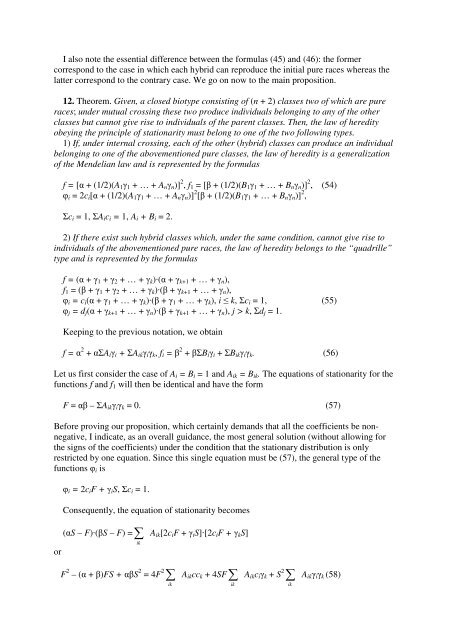kniga 7 - Probability and Statistics 1 - Sheynin, Oscar
kniga 7 - Probability and Statistics 1 - Sheynin, Oscar
kniga 7 - Probability and Statistics 1 - Sheynin, Oscar
You also want an ePaper? Increase the reach of your titles
YUMPU automatically turns print PDFs into web optimized ePapers that Google loves.
I also note the essential difference between the formulas (45) <strong>and</strong> (46): the formercorrespond to the case in which each hybrid can reproduce the initial pure races whereas thelatter correspond to the contrary case. We go on now to the main proposition.12. Theorem. Given, a closed biotype consisting of (n + 2) classes two of which are pureraces; under mutual crossing these two produce individuals belonging to any of the otherclasses but cannot give rise to individuals of the parent classes. Then, the law of heredityobeying the principle of stationarity must belong to one of the two following types.1) If, under internal crossing, each of the other (hybrid) classes can produce an individualbelonging to one of the abovementioned pure classes, the law of heredity is a generalizationof the Mendelian law <strong>and</strong> is represented by the formulasf = [ + (1/2)(A 1 1 + … + A n n )] 2 , f 1 = [ + (1/2)(B 1 1 + … + B n n )] 2 , (54) i = 2c i [ + (1/2)(A 1 1 + … + A n n )] 2 [ + (1/2)(B 1 1 + … + B n n )] 2 ,c i = 1, A i c i = 1, A i + B i = 2.2) If there exist such hybrid classes which, under the same condition, cannot give rise toindividuals of the abovementioned pure races, the law of heredity belongs to the “quadrille”type <strong>and</strong> is represented by the formulasf = ( + 1 + 2 + … + k )( + k+1 + … + n ),f 1 = ( + 1 + 2 + … + k )( + k+1 + … + n ), i = c i ( + 1 + … + k )( + 1 + … + k ), i k, c i = 1, (55) j = d j ( + k+1 + … + n )( + k+1 + … + n ), j > k, d j = 1.Keeping to the previous notation, we obtainf = 2 + A i i + A ik i k , f i = 2 + B i i + B ik i k . (56)Let us first consider the case of A i = B i = 1 <strong>and</strong> A ik = B ik . The equations of stationarity for thefunctions f <strong>and</strong> f 1 will then be identical <strong>and</strong> have the formF = – A ik i k = 0. (57)Before proving our proposition, which certainly dem<strong>and</strong>s that all the coefficients be nonnegative,I indicate, as an overall guidance, the most general solution (without allowing forthe signs of the coefficients) under the condition that the stationary distribution is onlyrestricted by one equation. Since this single equation must be (57), the general type of thefunctions i is i = 2c i F + i S, c i = 1.Consequently, the equation of stationarity becomesor(S – F)(S – F) =ikA ik [2c i F + i S][2c i F + k S]F 2 – ( + )FS + S 2 = 4F 2 ikA ik cc k + 4SFikA ik c i k + S 2 ikA ik i k (58)









